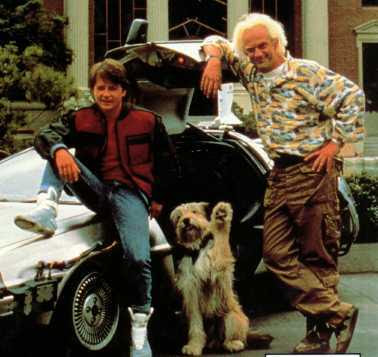 |
| No, not that one... |
 |
| Yup, that's the one! |
Thanks to his Flux Capacitor, Doc Brown was able to send his best friend forward in time by one minute. But what does science have to say about this historic journey? Is time travel - as seen in the Back to the Future trilogies even possible? What type of machine would be necessary to send a person into the past and bring them back?
One point of time travel that is often overlooked is space travel. The earth travels relative to the sun at a speed of about 30 km/sec (~67,000 mph). This means that Einstein's trip into the future by one minute would have left him about 1,800 km (~1,118 miles) behind the earth. Therefore, any time travel machine must also be an even more sophisticated space travel machine. In fact, space travel may be what actually limits time travel. Let me explain.
Remember that Einstein (the dog) traveled forward in time by one minute but also would have had to travel in space by about 1,800 km. There is a great article that uses some clever geometry to show that Doc Brown's furry friend would have had to travel at about 6 times the speed of light to move a single minute forward in time. That obviously can't happen. The situation is actually worse than that article described, though. Much worse. The calculations negates any movement of the solar system. However, the solar system is also orbiting the center of the Milky Way.. In the same minute that Einstein travels the 1,800 km relative to the solar system the sun itself travels ~28,000 km relative to the center of the Milky Way. If we use the center of the Milky Way as our reference frame, then when Marty McFly travels from 1955 to 1885 in Back to the Future III, he would have had to travel somewhere around 0.1 lightyears in the blink of an eye to catch up to the Earth.
Out of all the "Bad Science" articles I've written, though, Back to the Future is my favorite film. Because of that let's be a little bit bias. Let's allow Marty to break the universal speed limit every time he travels. Maybe the clue to how this all works is in the Flux Capacitor. Let's individually define those two words to see if we get any clues.
Flux: Physicists use the term flux to describe something's flow. Heat flux describes the rate that heat flows over an area, magnetic flux describes the rate that a magnetic field changes in a given area, etc. Flux isn't too bad of a word to use to use then, right? Time is an integral part of flux
(pun intended).

Capacitor: Doc Brown says that the stainless steel frame of the Delorean contributes to the "flux dispersal". Obviously there is some sort of electronic feedback that occurs. It makes sense, then, that you would want a capacitor. Capacitors are used in electrical devices to store current. Capacitors hold a charge.
Flux Capacitor: Utter nonsense. If we combine what the individual terms mean we are left with the idea that a flux capacitor somehow stores the flow of some current. Obviously this would be the flow of time, but that doesn't really make sense for a capacitor. I don't know any explanation of time that requires electricity, and I don't know of any use for a capacitor other than to hold an electric charge. Just because you're using fancy words doesn't mean you're saying anything fancy. The Flux Capacitor might have just been called the Turbo Encabulator.
If you liked this "Bad Science" post, check out the rest of the series!
